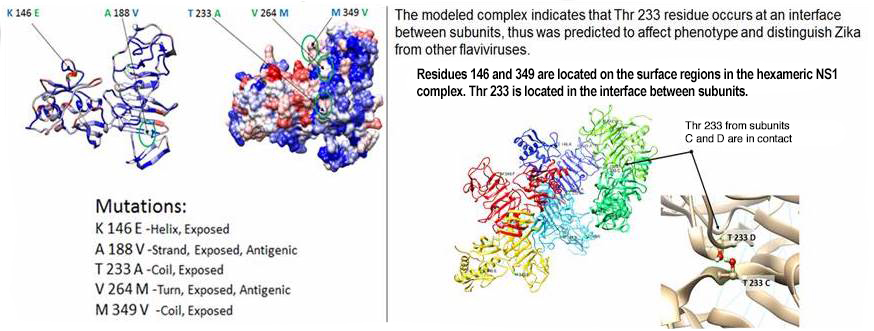Monica Borucki (17-ERD-019)
Executive Summary
We are working to analyze Zika virus outbreaks as they unfold, using cutting-edge predictive biology platforms to evaluate the potential for emergence of a genetic variant with increased transmissibility or virulence. With this project, we intend to develop computational modeling tools, experimental validation procedures, and bio-surveillance collaborations to create the capability needed for a flexible response to emerging viral threats.
Project Description
First isolated in 1947 from a monkey in Uganda, Zika virus was largely ignored until 2015 when it was implicated in a dramatic increase in microcephaly cases associated with a large outbreak of Zika virus infections in Brazil. The scientific community is urgently trying to understand how a seemingly mild strain of the virus became capable of sexual transmission, causing microcephaly in human newborns and paralytic symptoms in adults. If the virus adapts to more ubiquitous mosquito species or finds a new reservoir-host species in North America, widespread outbreaks could ensue, and the virus could become an endemic viral species. We are working to analyze the Zika virus outbreak as it unfolds, using cutting-edge predictive biology platforms to evaluate the trajectory of the epidemic. Our approach will use a combination of computational modeling, synthetic biology, and animal models to provide unique insight into the ongoing evolution of Zika virus and the potential for emergence of a genotype with increased transmissibility or virulence as has occurred with other newly introduced viruses transmitted by invertebrates. Guided by computational analysis of Zika virus genotypes present in outbreak samples, infectious clones of prevalent and persistent genotypes will be synthesized and characterized for host range and virulence. Data from experimental studies will be compared to predictions from computational structural models. The predictions will be assessed by generating synthetic Zika genomes, which will be evaluated for fitness and host range using in vitro assays. Those that show novel phenotypes will be characterized using in vivo models for assessment of viral virulence and fetal and sexual transmission. Mouse models will be used to assess the impact of emerging genotypes on mammalian host transmission and virulence.
We expect to develop a bio-surveillance test bed for vector-borne diseases in the Southeast Texas–Mexico border region, with a focus on identification of invertebrate-borne diseases such as Zika and Chikungunya in insect, animal, and human populations. We intend to perform in-depth genetic characterization of human and mosquito samples obtained from the Zika epidemic and provide the first comprehensive description of the diversity of the Zika virus population that may hold the key to its virulence and potential establishment in North America. These data will be compared to what is known for evolution mechanisms of closely related viruses, such as dengue and West Nile virus during outbreaks and host jumps, to identify sites within the Zika genome that may enable increased host range, virulence, or transmissibility if mutated. Genetic variants that are detected at relatively high frequency in multiple samples will be further assessed for changes in phenotype using protein structural modeling to ascertain if the mutant residue is likely to affect viral phenotype. We will produce a quantitative prediction for assessing the potential of existing circulating Zika virus strains to persist longer in the mammalian host, cause more severe disease, or adapt to new mosquito hosts, which would lead to potential permanent endemic status for Zika in North America. A successful outcome will enable development of synthetic-biology capabilities required for predictive biology and enhance Lawrence Livermore capabilities in host–pathogen biology. The project will also strengthen collaborations with Texas A&M University, with the Zika-infected mosquito (host) samples obtained as part of a new collaborative project between the Laboratory and Texas A&M.
Mission Relevance
Recent outbreaks of the Ebola and Zika viruses indicate that emerging and evolving RNA viruses are likely to remain one of the major biological threats to national security. In support of the Laboratory’s focus area in chemical and biological security, our research will help develop the computational modeling tools, experimental validation protocols, and bio-surveillance collaborations to create the technical capability needed for a flexible response to emerging viral threats. Our use of computational structural predictive models supports the core competency in high-performance computing, simulation, and data science. This research helps meet the DOE goal to transform our understanding of nature and strengthen the connection between advances in fundamental science and technology innovation.
FY17 Accomplishments and Results
We have made progress in characterization of Zika samples, construction of structural models to prioritize viral mutations for further analysis, construction of a synthetic Zika virus, and establishing a mouse model. Specifically, in FY17 we (1) tested mosquito samples from a region of Texas with local transmission for the presence of Zika RNA; (2) characterized tissues from macaques infected with Zika virus (from collaborators) and from our mouse model for a viral quasispecies (a group of viruses related by mutations competing in a highly mutagenic environment); (3) mined GenBank Sequence Read Archive data for mutation hot spots; (4) developed structure predictions for all Zika proteins and performed molecular dynamic modeling; (5) constructed a database of Zika mutations unique to each outbreak and used it to identify mutations with increased prevalence; and (6) constructed a synthetic clone of Zika.






